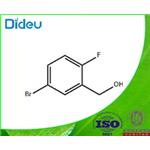The general procedure for the synthesis of 5-bromo-2-fluorobenzyl alcohol from 5-bromo-2-fluorobenzaldehyde was as follows: sodium borohydride (8.39 g, 222 mmol) was slowly added to an ethanol (EtOH) solution of 5-bromo-2-fluorobenzaldehyde (30.0 g, 148 mmol) at 0 °C. The reaction mixture was stirred at 0 °C, followed by a gradual warming to room temperature over 15 h. The reaction was carried out at 0 °C. The reaction was carried out at 0 °C. The reaction was carried out at 0 °C. Upon completion of the reaction, the mixture was again cooled to 0 °C and the reaction was quenched with saturated aqueous ammonium chloride (NH4Cl) solution. The reaction mixture was extracted with ethyl acetate (EtOAc) and the organic layer was separated. The organic layer was subsequently washed with brine, dried over anhydrous magnesium sulfate (MgSO4), filtered and concentrated under reduced pressure to afford 5-bromo-2-fluorobenzyl alcohol (30.3 g, quantitative yield) as a white solid, which can be used in subsequent reactions without further purification. [M-OH]+ 187.
[1] Patent: WO2011/159067, 2011, A2. Location in patent: Page/Page column 51
[2] Journal of Medicinal Chemistry, 1999, vol. 42, # 18, p. 3572 - 3587
[3] Patent: US6034093, 2000, A
[4] Patent: US5731315, 1998, A
[5] Patent: WO2004/814, 2003, A1. Location in patent: Page 49




